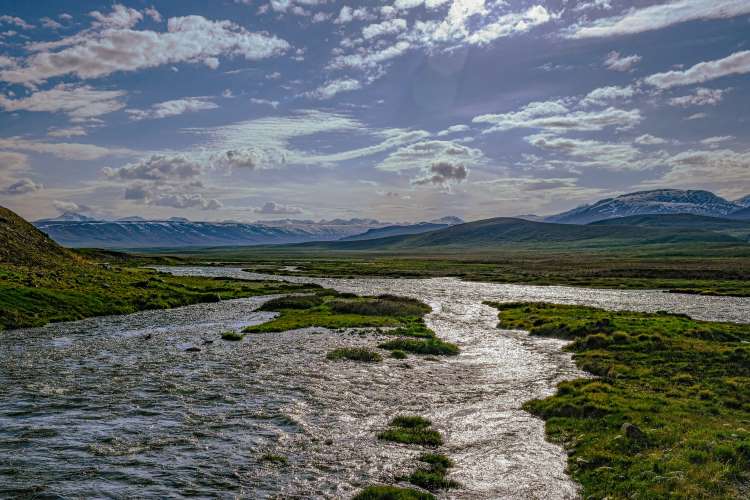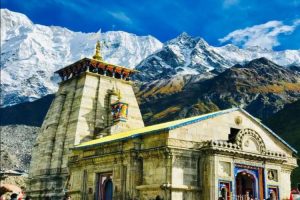
Drying Himalayan springs in Uttarakhand: The reconstruction of Kedarnath temple had raised several eyebrows with scientists, environmentalists, and religious leaders expressing concern over the heavy construction in ecologically fragile and geologically sensitive areas of the Himalayas. But the authorities paid no attention to the objections raised by the experts. Reconstruction work has now been proposed in the equally fragile and sensitive Badrinath Dham now. There is talk about the government planning heavy constructions in Badrinath too.
The reconstruction activities around the two ancient temples in the Himalayan region are not isolated incidents. Temple reconstruction activities are rampant across the state of Uttarakhand. Activities around the state’s smaller temples are generally funded by the people who have migrated to metro cities and foreign countries who wish to reconnect with their native villages. Many of them have not visited their native villages for a long time for various reasons and are unlikely to do so in the future too. Still, they wish to reconnect with their roots. Now they have money, but do not have any vision for contributing to village development.
READ I Char Dham road project should limit damage to Himalayan ecology
Himalayan springs, rivers drying up
While traveling through the hilly regions of Uttarakhand, large temples and dry abandoned water sources are common sightings along with water pipelines and handpumps. Most roadside farms are barren, with cattle roaming on the road is a common sight these days. Most of Uttarakhand’s inhabitants follow tribal culture. Most villages have their local deities like Bhairavnath, Bhumiyar Dev, Nagnath, or a multitude of goddesses are worshipped. Usually, the village temples are of small size for various reasons. But for some time now, the temples of these local deities are becoming grand in size.
On the other hand, the non-glacial rivers are drying up. According to a rough estimate, there are more than 50 lakh waterfalls in the entire Hindu Kush Himalayan region. If all water sources, small and large are counted, there will be crores of them. The number of waterfalls in the Indian region of the Himalayas is also more than three million. Most of the glacial rivers originating in the Himalayas form profound gorges; as a result, these are not usable for agricultural purposes, running water mills, or other day-to-day livelihood purposes in most places.

In contrast, the non-glacial rivers generated from the springs flow through shallow valleys. Most villages and towns are near these rivers or water sources, and their water is extensively used for irrigation and other purposes in the mountainous region. In addition to irrigation and fishing, the non-glacial rivers and springs are used to operate watermills or Gharats.
Apart from Himalayan springs and small water sources, non-glacial rivers have particular importance in developing society and civilization. Therefore, whenever information about Himalayan springs drying up or less water in non-glacial rivers surface, it is a cause of worry because of their direct link to the existence of Himalayan societies.
NITI Aayog in a 2018 report said that about half of the waterfalls in the Indian Himalayan region are drying up. This has affected thousands of villages which depend on natural spring water for domestic and livelihood needs such as drinking water and irrigation. As per an Uttarakhand government report, there are 15,165 villages in the state, and nearly 20% of them have a varied range of problems impeding the availability of drinking water.
The government of Uttarakhand has started an Uttarakhand Action Plan for Climate Change with the support of the United Nations Development Programme (UNDP) to counter this problem. The GB Pant Institute of Himalayan Environment has reported that more than 50% of the villages in Uttarakhand have lost their traditional water source. Now, they depend on water from other villages through pipelines.
No expert has, till now, established or denied any direct relationship between the drying up of springs and out-migration, but the number and speed of migration have indeed increased in recent years. It is also a fact that climate change has started showing its impact on the springs, ecology, agriculture, and wildlife.
The Rural Development and Migration Commission of the government of Uttarakhand has reported that the inhabitants have vacated 734 villages. These villages are called Bhutiya Villages or Ghost Villages, while in another 565, the population fell by 50% between 2011 and 2017. The reason for migration must be studied in-depth, considering that the non-availability of drinking water and the drying up of springs could be one of the reasons.
More than 20 crore people in India depend on springs for water, of which about five crore live in the 12 states of the Himalayan region. Nevertheless, Himalayan springs have yet to be given due attention. They are under tremendous pressure due to increasing water demand from urban centres where water sources have dried up, the moisture content near these springs is decreasing or becoming filthy.
The ecological degradation of mountainous areas to pave the way for mega infrastructure projects like railway lines, the Char Dham Road project, and other road projects have impacted these springs and water sources. Due to the drying up of the water bodies, pressure on other sources has increased. Piped water from these springs and lifting of water from these rivers for the use in distant places have become the easiest way to fulfil the ever-growing water demand. The nexus between politicians, bureaucracy, and contractors has aggravated the problem.
There is no doubt that the Himalayan ecosystem is fragile and sensitive to disturbance. This fragile ecosystem is susceptible to changes due to natural dynamics and anthropogenic interference. For example, the avalanche that occurred in the 18500 MSL at the high Himalayan region (Dropati ka Danda) in the first week of October 2022 resulted from excessive human intervention. Twenty-six mountaineers lost their lives in this natural calamity triggered by excessive human activity.
Similarly, on October 23, four family members were killed in a landslide in Panagarh village of Tharali tehsil of Chamoli district while sleeping in their home. At midnight, debris and big stones started falling at their house from the mountain and the entire family was buried under the rubble. Irregular rainfall and seismic activity in the Himalayan region, besides mega infrastructure projects like roads, railways, dams, and other construction, have made the region difficult for human habitation.
It is high time that government and community-based organisations played a leading role in creating public awareness about the drying springs. The migrants from Uttarakhand who are concerned about their villages must take up this issue. Their primary duty is to make people and government departments aware of the impact of the drying up of Himalayan springs. The traditional methods of spring-shed management for rejuvenating springs should be highlighted. The community, religious groups, and the government must help each other in initiating work to mitigate the effects of climate change. Recharging springs must be the first activity in this direction.
Policymakers and the political leadership of the region should work on a war footing to revive the Himalayan springs. The springs play a vital role in the overall development and existence of the mountain communities. It is also crucial for non-hill people who are not directly dependent on the springs as the drying up of non-glacial rivers will affect glacial rivers which are important to them.
The state government and the Himalayan communities should channel the resources from migrants to revive springs, non-glacial rivers and other traditional water sources. This is more important than building grand temples as springs are paramount to the survival of Himalayan communities and the ecosystem.
(Dr Prem Bahukhandi is an environmentalist based in Dehradun. He is a trustee of Friends of Himalaya, an NGO working on Himalayan communities.)
Dr Prem Bahukhandi is a researcher with experience in varied fields such as environment, economy, and society. He is a trustee of Friends of Himalaya, a non-profit organisation based in Dehradun.

